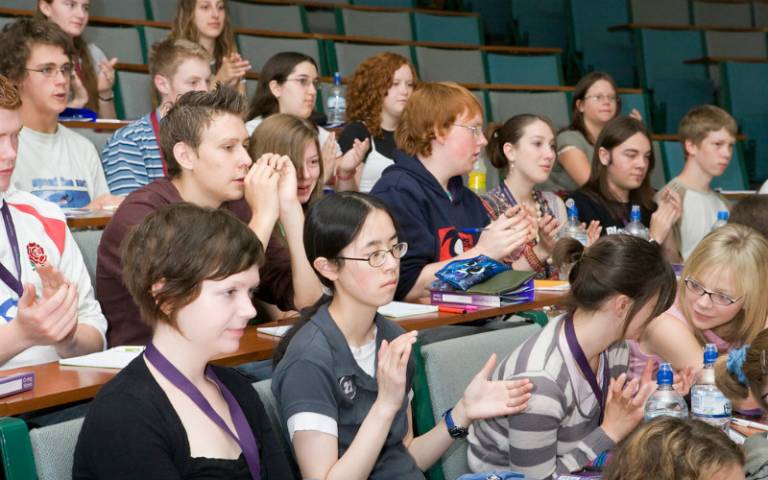Six ways to get students to really learn during a lecture
Dr Elinor Bailey, UCL Physics and Astronomy, shares some top tips for active learning

31 January 2019
As an undergraduate I usually found that I couldn’t concentrate and follow material in lectures for longer than about 10 minutes at a time (a common problem! [1,2]).
If you missed something in a physics lecture it could be very difficult to pick up the thread again. The rest of the lecture would then largely be a waste of time – I would copy everything down without taking it in and try to learn it later.
As a lecturer I have tried different techniques to help students follow the material and to help keep them engaged throughout the lecture.
Students have told me that they find these lectures effective because they actually learn the material during the lecture instead of just copying it down to learn later.
What’s so good about learning in the lecture?
Learning more during a lecture saves students time. You can facilitate active learning activities (that they may not do in their own study sessions) which promote deeper and longer-term learning [3]. Learning as they go encourages a lot more questions that students otherwise may not ask and may struggle with by themselves. Feeling like they are keeping up with the lectures also encourages a positive attitude to the course and reduces stress.
Here are the top six techniques I use:
1. Ask students to do one thing at a time
If you have something for students to read on a slide (even just one bullet point) wait in silence while they read it. If there is something to copy down give them time to do that before talking about it.
2. Go slowly
Reveal one line at a time in Powerpoint presentations. Wait for the students to make notes (if they are doing that) before revealing the next line. Give them thinking time - don’t fill all the silences with speaking. At the end of each slide ask students to put their hand up if they’re still writing and wait without speaking until they’ve all finished. Not talking when they are trying to read or make notes and giving them time to think gives them the best chance of following and thinking about the information.
3. Ask for questions
Be clear at the beginning of each lecture that you welcome questions at any time. Ask for questions after every slide and wait for at least a full 10 seconds – students may take time to formulate their question. You could even ask these to be submitted digitally (anonymously) during or after the lecture (so they could be summarised and answered at the start of the next lecture). Going slowly and constantly asking for questions results in much higher student engagement. It is also more inclusive as it encourages engagement from students who don’t usually participate in a lecture.
4. Get students to explain things back
Put students in pairs and for every difficult concept you have explained, ask person A to explain the first part back to B, and person B to explain the second part back to A. Allow a couple of minutes for this then ask for someone to explain to the room. Going over the material again in an active way will make it very clear to both them and you whether they have actually understood. Then go over the concept again if necessary.
5. Use quizzes
Use clickers to put quiz questions in your Powerpoint slides [4]. (It takes about 10 minutes to download TurningPoint for the UCL voting clickers and to get the hang of it). Get them thinking - if students have thought about something they are more likely to remember the answer when you tell them. Quiz questions get many more students thinking than a general ‘question to the room’ as they all have to participate. I have also had the comment that they find it reassuring to see if other students don’t know the answer either.
6. Mix it up
Don’t make them listen to you talking for a whole hour. Try to do multiple things in each lecture: quiz questions, A explain to B, set a puzzle or a problem for them to solve themselves, demonstrations, videos, tell them to read a section themselves before a class discussion of it, give them worksheet activities and so on. Mixing up activities as much as possible keeps them awake, and if they have lost the thread allows them to start back in when you start a new activity [3, 5].
If you are interested in more practical ideas for teaching in higher education please check out my blog at: higheredbarnacle.com
References
[1] Bligh, D. A. (2000) What’s the Use of Lectures? San Francisco: Jossey-Bass.
[2] Gibbs, G. & Habeshaw, T. (1989) Preparing to Teach. Bristol: Technical and Educational Services Ltd.
[3] Horgan, J. (2003) ‘Lecturing for Learning’, in H. Fry, S. Ketteridge & S. Marshall (eds) A Handbook for Teaching and Learning in Higher Education (2nd edition), pp. 75–90. London: RoutledgeFalmer.
[4] Guthrie, Rand and Anna Carlin. “Waking the Dead: Using interactive technology to engage passive listeners in the classroom.” AMCIS (2004).
[5] Young, M. S., Robinson, S., & Alberts, P. (2009). Students pay attention!: Combating the vigilance decrement to improve learning during lectures. Active Learning in Higher Education, 10(1), 41–55.
 Close
Close

